NVIDIA’s GeForce GTX 480 and GTX 470: 6 Months Late, Was It Worth the Wait?
by Ryan Smith on March 26, 2010 7:00 PM EST- Posted in
- GPUs
Temperature, Power, & Noise: Hot and Loud, but Not in the Good Way
For all of the gaming and compute performance data we have seen so far, we’ve only seen half of the story. With a 500mm2+ die and a TDP over 200W, there’s a second story to be told about the power, temperature, and noise characteristics of the GTX 400 series.

Starting with idle temperatures, we can quickly see some distinct events among our cards. The top of the chart is occupied solely by AMD’s Radeon 5000 series, whose small die and low idle power usage let these cards idle at very cool temperatures. It’s not until half-way down the chart that we find our first GTX 400 card, with the 470 at 46C. Truth be told we were expecting something a bit better out of it given that its 33W idle is only a few watts over the 5870 and has a fairly large cooler to work with. Farther down the chart is the GTX 480, which is in the over-50 club at 51C idle. This is where NVIDIA has to pay the piper on their die size – even the amazingly low idle clockspeed of 50MHz/core 101MHz/shader 67.5Mhz/RAM isn't enough to drop it any further.

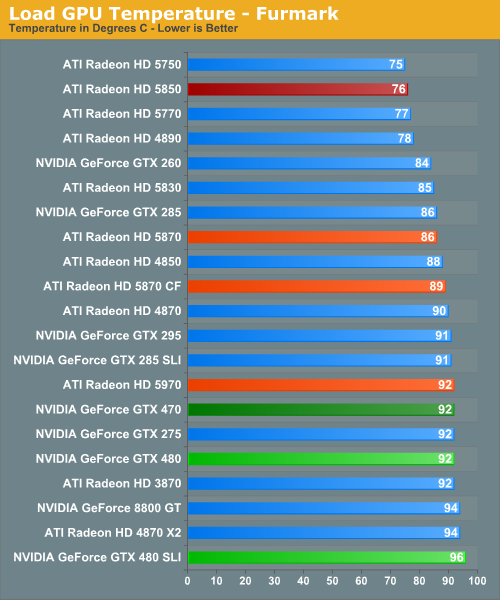
For our load temperatures, we have gone ahead and added Crysis to our temperature testing so that we can see both the worst-case temperatures of FurMark and a more normal gameplay temperature.
At this point the GTX 400 series is in a pretty exclusive club of hot cards – under Crysis the only other single-GPU card above 90C is the 3870, and the GTX 480 SLI is the hottest of any configuration we have tested. Even the dual-GPU cards don’t get quite this hot. In fact it’s quite interesting that unlike FurMark there’s quite a larger spread among card temperatures here, which only makes the GTX 400 series stand out more.
While we’re on the subject of temperatures, we should note that NVIDIA has changed the fan ramp-up behavior from the GTX 200 series. Rather than reacting immediately, the GTX 400 series fans have a ramp-up delay of a few seconds when responding to high temperatures, meaning you’ll actually see those cards get hotter than our sustained temperatures. This won’t have any significant impact on the card, but if you’re like us your eyes will pop out of your head at least once when you see a GTX 480 hitting 98C on FurMark.
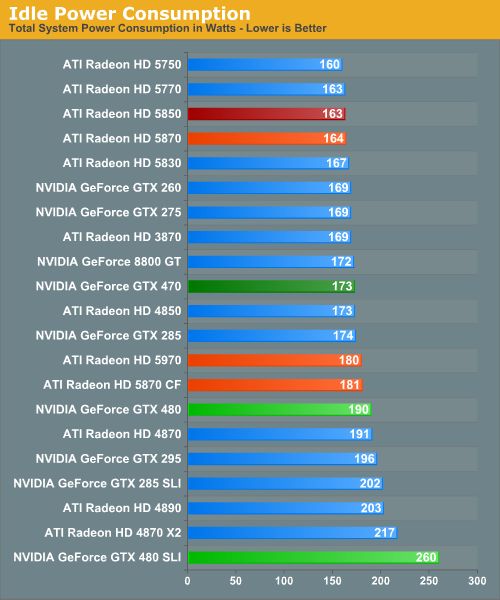
Up next is power consumption. As we’ve already discussed, the GTX 480 and GTX 470 have an idle power consumption of 47W and 33W respectively, putting them out of the running for the least power hungry of the high-end cards. Furthermore the 1200W PSU we switched to for this review has driven up our idle power load a bit, which serves to suppress some of the differences in idle power draw between cards.
With that said the GTX 200 series either does decently or poorly, depending on your point of view. The GTX 480 is below our poorly-idling Radeon 4000 series cards, but well above the 5000 series. Meanwhile the GTX 470 is in the middle of the pack, sharing space with most of the GTX 200 series. The lone outlier here is the GTX 480 SLI. AMD’s power saving mode for Crossfire cards means that the GTX 480 SLI is all alone at a total power draw of 260W when idle.
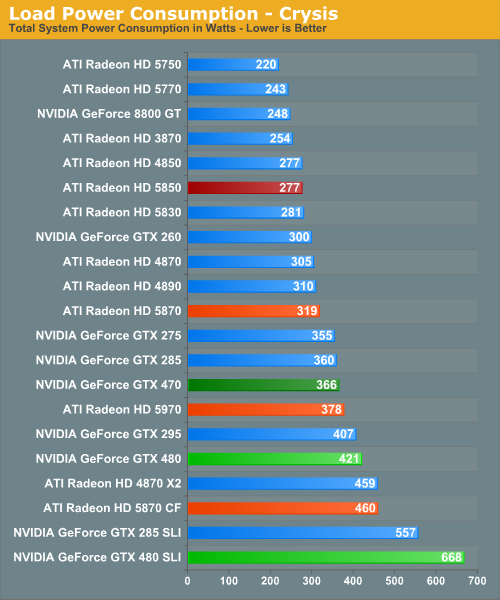
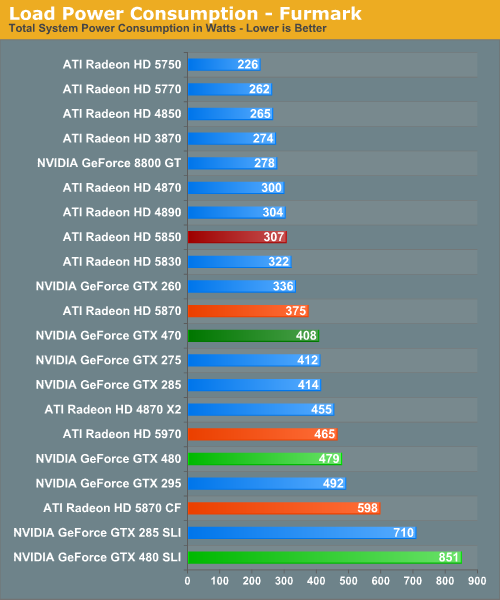
For load power we have Crysis and FurMark, the results of which are quite interesting. Under Crysis not only is the GTX 480 SLI the most demanding card setup as we would expect, but the GTX 480 itself isn’t too far behind. As a single-GPU card it pulls in more power than either the GTX 295 or the Radeon 5970, both of which are dual-GPU cards. Farther up the chart is the GTX 470, which is the 2nd most power draining of our single-GPU cards.
Under FurMark our results change ever so slightly. The GTX 480 manages to get under the GTX 295, while the GTX 470 falls in the middle of the GTX 200 series pack. A special mention goes out to the GTX 480 SLI here, which at 851W under load is the greatest power draw we have ever seen for a pair of GPUs.

Idle noise doesn’t contain any particular surprises since virtually every card can reduce its fan speed to near-silent levels and still stay cool enough. The GTX 400 series is within a few dB of our noise floor here.
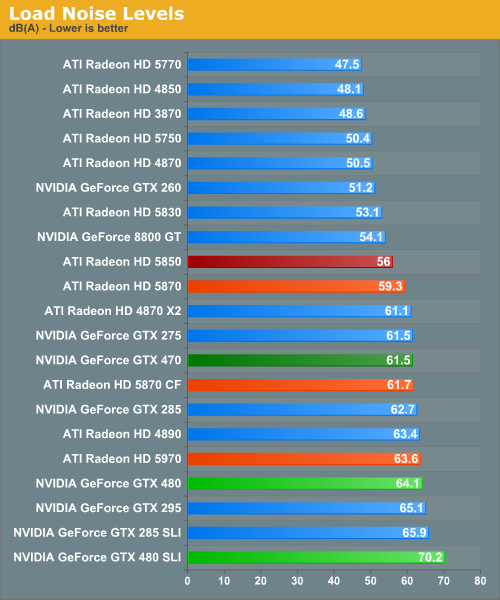
Hot, power hungry things are often loud things, and there are no disappointments here. At 70dB the GTX 480 SLI is the loudest card configuration we have ever tested, while at 64.1dB the GTX 480 is the loudest single-GPU card, beating out even our unreasonably loud 4890. Meanwhile the GTX 470 is in the middle of the pack at 61.5dB, coming in amidst some of our louder single-GPU cards and our dual-GPU cards.
Finally, with this data in hand we went to NVIDIA to ask about the longevity of their cards at these temperatures, as seeing the GTX 480 hitting 94C sustained in a game left us worried. In response NVIDIA told us that they have done significant testing of the cards at high temperatures to validate their longevity, and their models predict a lifetime of years even at temperatures approaching 105C (the throttle point for GF100). Furthermore as they note they have shipped other cards that run roughly this hot such as the GTX 295, and those cards have held up just fine.
At this point we don’t have any reason to doubt NVIDIA’s word on this matter, but with that said this wouldn’t discourage us from taking the appropriate precautions. Heat does impact longevity to some degree – we would strongly consider getting a lifetime warranty for the GTX 480 to hedge our bets.










196 Comments
View All Comments
mcnabney - Friday, March 26, 2010 - link
You make the most valid point.As long as the consoles are in the driver's seat (this isn't going to change) DX11 and the features it provides won't be widely found in games until the next generation of consoles - in 2-3 years.
So really, without growth in the PC gaming market these is no need to upgrade from the last generation. Too bad really.
GourdFreeMan - Friday, March 26, 2010 - link
Thank you for listening to our feedback on improving your test suite of games, Ryan. I think your current list much better represents our interests (fewer console ports, a selection of games that better represent the game engines being used in current and future titles, fewer titles with GPU vendor bias, inclusion of popular titles that have staying power like BF:BC2, etc.) than the one you used to review the 58xx's when they were released. The only title that I feel that is missing from our suggestions is Metro 2033. Kudos!yacoub - Friday, March 26, 2010 - link
Good review. The grammar errors are prolific, but I guess this was rushed to release or something.So it's a hot, power-hungry card with a high pricetag. Not too surprising.
Would have liked to see a $150-range Fermi-based card sometime this year so I can ditch my 5770 and get back to NVidia, but the high temps and prices on these cards are not a good sign, especially comparing the performance against the 5800-series.
AznBoi36 - Saturday, March 27, 2010 - link
Fanboy much?yacoub - Saturday, March 27, 2010 - link
Fanboy of what?The ATI card I have now that I can't wait to get rid of?
The desire for NVidia to release something competitive so I can get back to a stabler driverset and remove all traces of ATI from this PC?
mcnabney - Saturday, March 27, 2010 - link
Ah yes, get back to Nvidia whose last trick was releasing a driver that turned off GPU fans causing instant-card-death.With 480, turning off the fan might actually start a fire.
Headfoot - Monday, March 29, 2010 - link
I bet you experienced that fan error IRL right?Just like how everyone who owned a Phemon got a TLB error 100% of the time right?
numberoneoppa - Friday, March 26, 2010 - link
You know you have the best tech site around when a product review makes it seem like a ddos is in progress.As far as the review itself, it's very comprehensive, so thanks Ryan! The new NVIDIA cards seem to be just where most people thought they would be. It really makes me anticipate the next HD58xx card and the AMD price cuts on the current line up that will come with it.
Devo2007 - Friday, March 26, 2010 - link
Great review, although you may want to edit this sentence:"NVIDIA meanwhile had to deal with the fact that they were trying to produce a very large chip on a low-yielding process, a combination for disaster given that size is the enemy of high yields."
Shouldn't it be "large size is the enemy of low yields?" Either way, that end point seems a bit redundant.
SlyNine - Saturday, March 27, 2010 - link
No, Large size would be a friend of low yeilds. low yeilds are our enemy.